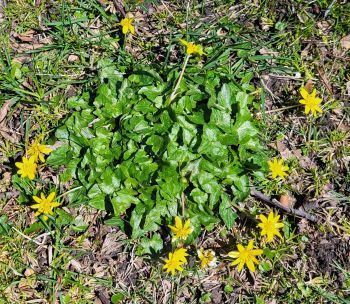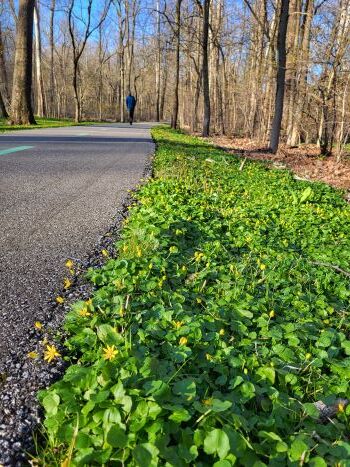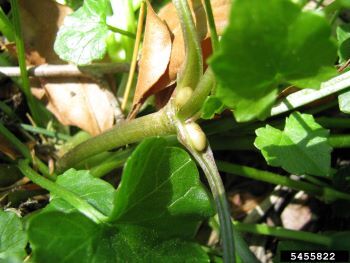|
July 30, 2024
Contact: Katie Grzesiak, 231-492-7811, or Joanne Foreman, 517-284-5814
Five other plants get new common names
Lesser celandine (Ficaria verna), an invasive plant that has been cropping up in floodplain forests in mid-Michigan, has been added to the state’s invasive species watch list. The designation recognizes the threat the plant poses to native habitats and encourages public reporting of lesser celandine sightings.
The addition was part of an annual review of the watch list, which also provided Michigan’s Invasive Species Program the opportunity to update the common names of five terrestrial (land-based) plants, opting for descriptive names over those referring to places of origin.
Lesser celandine
Lesser celandine (pronounced seh·luhn·dine) is a non-native, low-growing perennial plant in the buttercup family, most often found along streams and in forested floodplains. Characterized by heart-shaped leaves and glossy yellow flowers, it can spread by seeds, tubers (underground stems) and bulbils (tiny bulblike structures where the leaf meets the stem). These three methods of reproduction allow the plant to spread rapidly in areas with disturbed soils, including banks scoured by flooding, paths and open areas, crowding out native plants like spring beauties and trilliums, which inhabit similar spaces.

As a spring ephemeral – a short-lived species that sprouts early in spring, flowers, goes to seed and then completely dies back and disappears well before summer begins – lesser celandine is particularly difficult to control.
"Lesser celandine isn't a regulated species in Michigan, and it's not commonly sold today, but it was first brought here as a spring interest species for gardens," said Susie Iott, invasive species program specialist for the Michigan Department of Agriculture and Rural Development.
It recently has been identified in some areas of the Grand River watershed, but lesser celandine may be in other locations as well.
|

"With the prioritization afforded by the watch list, we're hoping reports by partners and the public can help us understand how far the invasion extends so we can make the best decisions about how to steward our resources – both financial and natural," said Katie Grzesiak, terrestrial invasive species coordinator with the Michigan Department of Natural Resources.
Sightings of lesser celandine, visible in early spring, can be reported through the Midwest Invasive Species Information Network or on the free MISIN app. Note that Michigan’s native marsh-marigold can be confused for lesser celandine, but it is often two to four times the size of lesser celandine, growing up to 2 feet tall, with larger flowers and leaves that last throughout the summer.
More information on identifying, reporting and preventing the introduction or spread of watch list species is available at Michigan.gov/Invasives/ID-Report/Watchlist.
|
Name changes
As part of a broader effort to improve naming of invasive species to better communicate their descriptions while avoiding place-based or potentially derogatory terms, five terrestrial plants are getting updated common names on Michigan’s invasive species website.
-
Calligraphy sedge will replace Asiatic sand sedge as the common name for Carex kobomugi, a species not known to be present in Michigan.
-
Chaff flower will be used instead of Japanese chaff flower to refer to Achyranthese japonica, an invasive floodplain plant not known to be present in Michigan.
-
Cinnamon vine will be used as the common name for Discorea polystachya. Formerly referred to as Chinese yam, this fast-growing vine with potatolike tubers is found in several locations in Michigan.
-
Purple jewelweed will be used in place of Himalayan balsam as the common name for Impatiens glandulifera, an invasive flowering plant found in areas of the Upper Peninsula.
-
Stiltgrass will replace Japanese stiltgrass as the common name for Microstegium vimineum, an invasive annual grass found in some areas of southern Michigan.

“Each known plant and animal species has a single scientific name, usually in Latin, which is used as its primary identifier. Common names are the nicknames we give to species,” said Grzesiak. “Sometimes they are descriptive of the plant, and other times they might relate to a species’ perceived origin or qualities.”
Many plants, especially those considered weeds, can have several common names. For example, common tansy (Tanacetum vulgare) is also known as golden buttons, bitter buttons and cow bitters.
"In choosing appropriate common names, we look first at what other states and countries are calling these plants," said Grzesiak. "If there isn't a good candidate, we think about identifying characteristics, historic uses or in what kind of habitat they're found."
|
The scientific, Latin names of the species won’t be changed, and the previous common names will remain as references on State of Michigan webpages for the foreseeable future to assist with the transition. The Michigan Invasive Species Program plans to work with regional and national partners to continue evaluating common names of watch list species.
What is the watch list?
Michigan’s watch list identifies species that pose an immediate or potential threat to the economy, environment or human health. Watch list species have limited known distribution or have never been confirmed in the wild in the state. Michigan’s Invasive Species Program prioritizes watch list species and encourages the public to report potential sightings and take precautions to prevent establishment or limit their spread.
Several factors are considered in evaluating species for watch list status, including risk assessments, proximity of populations to Michigan, harmful characteristics and availability of control methods.
Michigan's Invasive Species Program is cooperatively implemented by the Department of Environment, Great Lakes, and Energy; the Department of Natural Resources; and the Department of Agriculture and Rural Development.
Note to editors: Accompanying photos are available below for download. Caption information follows.
Celandine plant: Lesser celandine is a spring ephemeral plant with shiny green leaves and glossy yellow flowers. Photo courtesy of Michigan DNR.
Celandine trail: In early spring, lesser celandine covers the ground beside a paved trail near the Grand River in Michigan. Photo courtesy of Michigan DNR.
Bulbils: Small bulbils, capable of producing new plants, grow between the leaf base and stem on a lesser celandine plant. Photo courtesy of Leslie J. Mehrhoff, University of Connecticut, Bugwood.org.
|